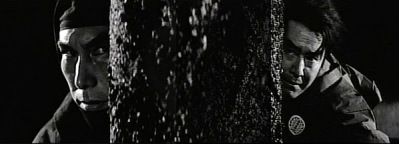The Criterion Collection, a continuing series of important classic and contemporary films presents Ninja Hunt.
 When the corrupt Tokugawa shogunate seeks to abolish the Matsuyama clan during a transition of power and seize its wealth, it deploys its sinister Koga ninja to destroy an official proclamation that would confirm the clan’s new heir. Aware of the shogunate plot, the Matsuyama clan hires four ronin whose clans were dissolved in similar plots and charges them to protect the proclamation and ferret out the ninja spies by any means. These masterless samurai, led by the elder swordsman Wadakuro (Jûshirô Konoe), pursue their vengeance against the Koga ninja with brutal and single-minded intensity. A masterpiece of the ninja film craze of the 1960s that remains little known outside of Japan, Tetsuya Yamauchi’s first film is a highly suspenseful and bitterly violent thriller.
When the corrupt Tokugawa shogunate seeks to abolish the Matsuyama clan during a transition of power and seize its wealth, it deploys its sinister Koga ninja to destroy an official proclamation that would confirm the clan’s new heir. Aware of the shogunate plot, the Matsuyama clan hires four ronin whose clans were dissolved in similar plots and charges them to protect the proclamation and ferret out the ninja spies by any means. These masterless samurai, led by the elder swordsman Wadakuro (Jûshirô Konoe), pursue their vengeance against the Koga ninja with brutal and single-minded intensity. A masterpiece of the ninja film craze of the 1960s that remains little known outside of Japan, Tetsuya Yamauchi’s first film is a highly suspenseful and bitterly violent thriller.
Disc Features:
- High-definition digital restoration, with uncompressed monaural soundtrack on the Blu-ray edition
- Trailer
- New English subtitle translation
- PLUS: A booklet featuring a new essay by film scholar Alain Silver and critic, novelist, and musician Chris D.
Tales of the ninja have always been popular in Japan, but it was in the 1960s that these silent assassins hit cinema screens as a full blown craze. Studios like Daiei, Toei, and Toho cranked out ninja films to the public’s delight, sometimes presenting them as antagonists against heroic samurai and sometimes casting them as conflicted protagonists caught between their duty to their mission and their treatment as expendable tools to political wills. The Criterion Collection has only dipped its proverbial toe into this subset of the chambara, with Masahiro Shinoda’s Samurai Spy (1965) being the only ninja film to garner a spine number. Samurai Spy belongs to the “samurai vs. ninja” variety and is notable for its complex plot and its overtly artful and theatrical style typical to Shinoda’s work. The ninja cinema of the ’60s includes many great examples of the subgenre worthy of further attention by the Collection. Tetsuya Yamauchi may not be a household name among Western cinephiles, but his Ninja Hunt (1964) is a nearly perfect and perfectly brutal tale of vengeance set in the years following the Tokugawa shogunate’s consolidation of power.
Ninja Hunt has the benefit of having a fairly straightforward plot. The lord of the Matsuyama clan approaches death and the clan requires the consent of the Tokugawa shogunate to transition their lord’s authority to his barely school-age heir. That consent is provided in the form of an official letter which will be given to a representative of the shogunate upon his arrival at the Matsuyama clan’s castle, whereupon he will be duty bound to collect the young heir and safely transport him to Edo for his confirmation. The Matsuyama clan had previously been an ally to Tokugawa’s rival during the wars and is the last of those allies not to have been dissolved by Japan’s new rulers. The Tokugawa shogunate would like nothing better than to absorb the Matsuyama clan entirely, but to do so it must free itself of its traditional obligation to confirm its heir. To this end, the Koga ninja are retained to destroy the letter and create a pretext for refusing the necessary transfer of authority to the Matsuyama heir. Aware of this risk, the Matsuyama clan’s top official, Gamo (Takahiro Tamura), hires 4 ronin to weed out the ninja spies within his clan and protect both the letter and the young heir. The ronin, led by the elder samurai Wadakuro (Jûnshirô Konoe), each come from clans victimized by the same Tokugawa plot and are obsessed with completing their task and destroying the Koga ninja at any cost. Their vicious single-mindedness is appalling to the remainder of the Matsuyama clan, but Goma is unwavering in his faith in these hard-bitten swordsmen. Spies are revealed, ambushes are made, and Ninja Hunt culminates in a life or death battle between the ninja leader, Kura, and the ronin Wada and Hachi (Kei Sato) while sealed within an underground burial tomb. This end sequence is heavily shadowed and evocatively staged, but remains coherently presented and concludes with a pair of deaths as grimly brutal as can be imagined.
Yamauchi’s film is most often compared in Western reviews as something akin to film noir, presumably for its anti-hero protagonists; its sudden, shocking violence; and its final duel shot in chiaroscuro. Personally, such a comparison seems strained, as Ninja Hunt lacks the liminal settings; the double crosses; or even the cool, weary ambivalences of film noir. To me, the film more easily compares to Westerns, particularly revisionist Westerns, with clear delineations between the sides of the subject conflict while questioning the methods and morals of its heroes. Wadakuro and his colleagues are far more akin to drifters hired by a town to protect it from outlaws than noir’s dicks, hoods, and dames, far more comparable to 3:10 to Yuma (Delmer Daves, 1957) than Kiss Me Deadly (Robert Aldrich, 1955). Most interestingly, Ninja Hunt can be seen as a variation on the siege film. While most siege films involve a select group of individuals attempting to protect their refuge from swarming masses of zombies or Zulu, aliens or Apache, Ninja Hunt‘s ronin repel far more insidious invaders who use stealth and deception rather than brute force and sheer numbers to accomplish their goals. In an odd way, the film compares to another slow burn siege movie, John Carpenter’s The Thing (1982). Both films emphasize expelling the infiltrating danger over resisting the outside onslaught. I’m reluctant to propose too close a kinship between these two films, but it is notable that each contains a fearsome sequence where the film’s protagonist works to determine who in a captive group is a dangerous infiltrator. In the case of Ninja Hunt, this section involves Wadakuro killing a series of Matsuyama samurai until the ninja spy reveals his training in an effort to save himself. Wadakuro cuts the Koga ninja down, driving the lone innocent survivor of the questioning mad at this traumatizing process. Ninja Hunt mixes the pop culture version of the ninja as desired by commercial audiences (the black suits, the superhuman leaps, Kura’s pin-spitting technique which he uses to blind his opponents) with the true aspects of these historical figures (the espionage, the reliance on disguise by posing as priests, peasants, and the like) to create a tension-building, legitimately dangerous threat to be faced and vanquished by a mere 4 men.
 Ninja Hunt is an exciting and expertly made film, full of excellent performances by recognizable Japanese stars and carried by a brooding, arrhythmic score compliments of the great Toshiaki Tsushima. The film works as both purely commercial entertainment and as an admirably stylish aesthetic achievement. Its presence in the Collection would allow for further exploration of an important subgenre of Japanese cinema that has only been touched upon thus far by Criterion. A wacky “C” would raise this great film’s profile, something presently denied in part because Tetsuya Yamauchi is not a celebrated, canonical auteur. As much as we love original cover commissions, this image of Wadakuro and Kura opposed on either side of one of the tomb’s pillars nicely encapsulates the rivalry between the two warriors and its heavy blacks and low fill/high key lighting provides a striking and representative description of the film’s aesthetic.
Ninja Hunt is an exciting and expertly made film, full of excellent performances by recognizable Japanese stars and carried by a brooding, arrhythmic score compliments of the great Toshiaki Tsushima. The film works as both purely commercial entertainment and as an admirably stylish aesthetic achievement. Its presence in the Collection would allow for further exploration of an important subgenre of Japanese cinema that has only been touched upon thus far by Criterion. A wacky “C” would raise this great film’s profile, something presently denied in part because Tetsuya Yamauchi is not a celebrated, canonical auteur. As much as we love original cover commissions, this image of Wadakuro and Kura opposed on either side of one of the tomb’s pillars nicely encapsulates the rivalry between the two warriors and its heavy blacks and low fill/high key lighting provides a striking and representative description of the film’s aesthetic.
Credits: Criterion’s more recent Japanese releases, particularly their genre films, have been slim on special features, being satisfied with trailers, essays, and liner notes. Given the lack of auteur status associated with Yamauchi, it’s difficult to anticipate a bounty of special features here. Chris D.’s wealth of Japanese genre film knowledge contained in his expansive notes in the Zatoichi: The Blind Swordsman box set suggests he may have enthusiasm and insight for a Criterion edition of Ninja Hunt. Alain Silver provided the essay for Samurai Spy, a film that takes place in roughly the same era as Ninja Hunt and similarly addresses the Tokugawa shogunate’s consolidation of power, and so we’ve chosen him to provide an analysis of this film as well.